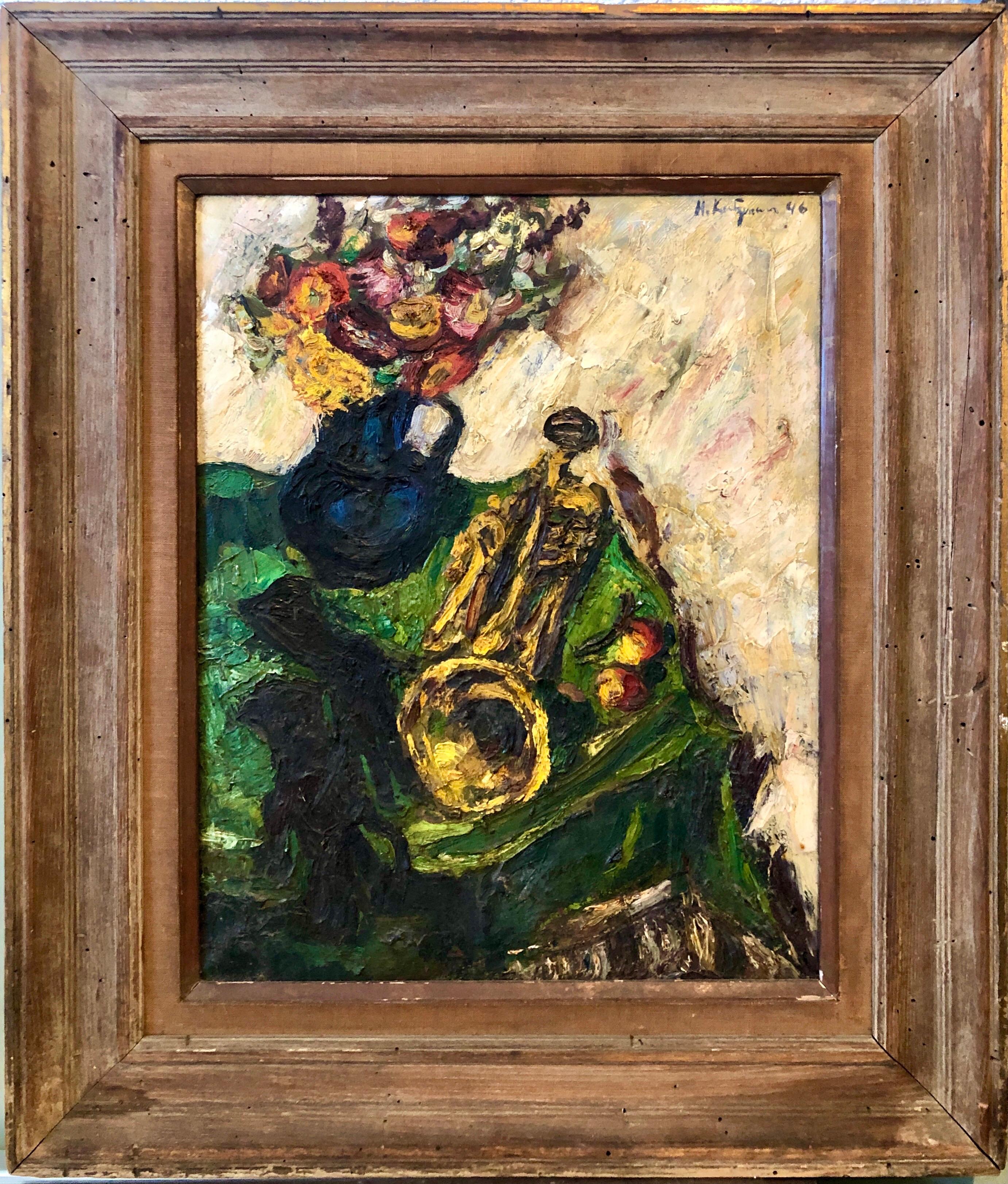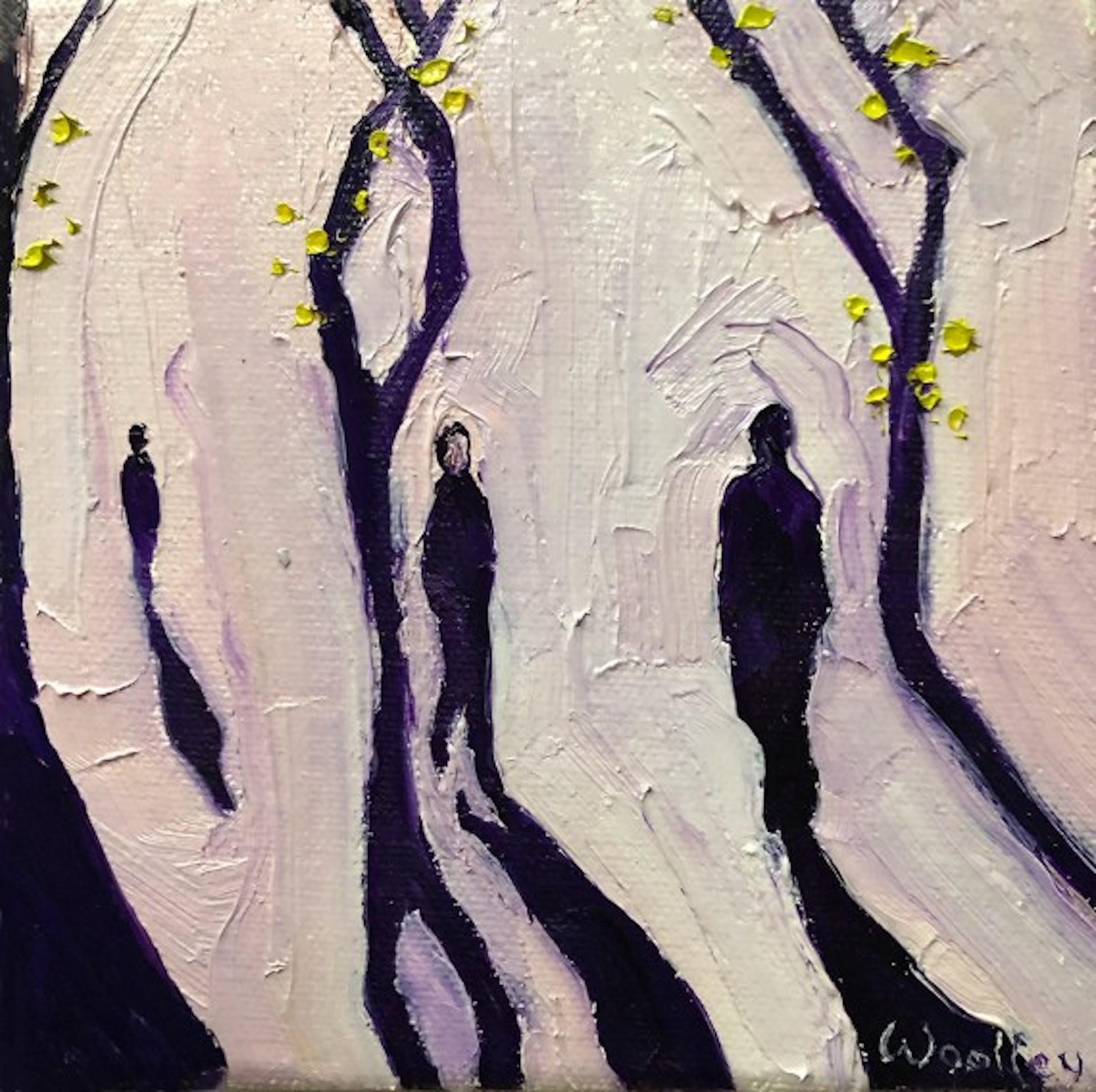Items Similar to "The Opera Singer" Expressionist Oil Portrait on Panel by Maurice Saint-Lou
Want more images or videos?
Request additional images or videos from the seller
1 of 9
Maurice Saint-Lou"The Opera Singer" Expressionist Oil Portrait on Panel by Maurice Saint-Lou1945
1945
About the Item
Expressionism, a revolutionary art movement of the early 20th century, aimed to elicit emotional responses, often exposing the harshest and most tumultuous aspects of the human condition and psyche. With this oil portrait of a lyrical singer, the artist uses distortion and exaggeration to present a subjective reality. Opera is anchored in a universe where human passions are unleashed. Love, tragedy, and death are often at the heart of the intrigues.
We can observe the vivid and distorted use of color and lines. The painter employs this expressive technic to suggest the hidden internalized world of the interpreter, capturing both her physical presence and concentration. A long face carved with a billhook, asymmetrical, with the contours finely highlighted in black, and the open mouth, whose lips are powerfully painted in red, occupies the upper part of the painting. At the same time, the rest of the body is cut just above the thighs. She holds a musical score in one hand.
In an economy of details, the artist successfully infuses the body's language with an astonishing intensity. A red evening dress, eloquent fingers, blond hair, the fringe of which would almost have moved under a tumultuous interpretation engaging voice and body. The eyes are wide open, the mouth grimacing. No jewelry appears on her immaculate skin. The artist probably chose to insist and direct our attention precisely to this moment of embodiment, without being distracted by accessories, sober background reflecting light to keep directing our attention to the subject.
The profound emotional upheaval, the soul's descent into the abyss of heartache, and the crucible of genuine passion - present themselves to us almost intimidatingly so that we can dissect and confront them, having received the image like a punch to the heart and in the gut, in front of the raw power embedded in the frame.
It is worth considering the role of color in stimulating our souls as viewers. Vibrant red becomes a metaphor for visceral passion. Like the haunting voice of the opera singer, the work penetrates deep into the psyche. The tension exuded initiates a back-and-forth dynamic with our perspectives, showcasing the power of art as a catalyst for introspection and inviting us to confront the mirror of our most intimate realities.
Maurice Saint-Lou was born on 24 October 1897 in Paris, France. He is known for painting and acting. He is known for L'ennemi sans visage (1946) and Der Ruf Tsum Leben (1946). He died in 1961.
- Creator:Maurice Saint-Lou (1897 - 1961, French)
- Creation Year:1945
- Dimensions:Height: 37.25 in (94.62 cm)Width: 26.75 in (67.95 cm)Depth: 1.5 in (3.81 cm)
- Medium:
- Movement & Style:
- Period:
- Condition:
- Gallery Location:Pasadena, CA
- Reference Number:1stDibs: LU654314193952
About the Seller
5.0
Vetted Seller
These experienced sellers undergo a comprehensive evaluation by our team of in-house experts.
Established in 1999
1stDibs seller since 2017
51 sales on 1stDibs
Typical response time: 16 hours
- ShippingRetrieving quote...Ships From: Pasadena, CA
- Return PolicyA return for this item may be initiated within 3 days of delivery.
More From This SellerView All
- French Mid-Century "The Polytechnique Students" Painting by Bernard CornilleLocated in Pasadena, CAThe 14th of July is the National Day in France. That night every high school in Paris have an orchestra playing in the streets. This painting is depicting musicians students expres...Category
Mid-20th Century Expressionist Figurative Paintings
MaterialsOil, Canvas
- "Duck Lake" California Expressionist Oil Landscape by John Mitchell MartinLocated in Pasadena, CAThis oil painting features a calm lake where eleven black ducks swim. The artist painted a water pipe on the lake's left bank while a palm tree stands alone at the center. John Mit...Category
20th Century Expressionist Figurative Paintings
MaterialsCanvas, Oil
- Still-Life Blue Tones Oil on Canvas by Edward SotelloLocated in Pasadena, CAWith this oil painting realized by the Californian artist Edward Sotello, we can clearly see on the right a glass, a vase, and some flowers placed on a table. On the left, a possible...Category
Mid-20th Century Expressionist Still-life Paintings
MaterialsOil, Canvas
- Signed Oil on Canvas Portrait of a Young BoyLocated in Pasadena, CAThe aesthetics of the human figure in art offer a captivating perspective for artists and enthusiasts, a delicate balance between simplicity and subtlety. In this oil painting, a you...Category
1940s Expressionist Figurative Paintings
MaterialsOil, Canvas
- Dyptich Rural scenes from the Chinese Countryside - Oil Painting - a PairLocated in Pasadena, CAThis peaceful pair of 19th Century paintings show two rural scenes from the Chinese countryside. One is a shepherd sitting by the river,...Category
19th Century Expressionist Figurative Paintings
MaterialsOil
- "Two Yellow Parakeets and the Surviving Plant" Oil Painting by Pat BergerLocated in Pasadena, CASomething is mesmerizing about the paintings of Pat Berger - a captivating force that immediately draws us in. Her work is characterized by a unique composi...Category
1950s Expressionist Figurative Paintings
MaterialsOil
You May Also Like
- Self Portrait, Expressionist Figurative Portrait by Philadelphia ArtistBy Bernard HarmonLocated in Doylestown, PA"Self Portrait" is a painting by Philadelphia born Expressionist painter Bernard Harmon. The 47" x 28.5" oil on canvas portrait features Harmon at a young age of about 25 years old. ...Category
1960s Expressionist Portrait Paintings
MaterialsCanvas, Oil
- Modern Man, Expressionist Portrait in Red, White, and BlueBy Bernard HarmonLocated in Doylestown, PA"Modern Man" is a painting by Philadelphia born Expressionist painter Bernard Harmon. The 40" x 36" oil on canvas portrait features a young African American man posing casually and s...Category
1970s Expressionist Portrait Paintings
MaterialsCanvas, Oil
- Polish French Jewish Artist Oil Painting Girl with Doll, School of Paris JudaicaBy Walter SpitzerLocated in Surfside, FLFramed 27 X 24 inches Sight 18 X 15 inches Walter Spitzer (Polish/French, 1927 - ) born in Cieszyn, Poland. A Polish Jewish Holocaust survivor, he made his first drawings in a concentration camp. Walter Spitzer has lived and worked since WWII in France, where he studied at the École des Beaux Arts in Paris. Walter Spitzer has achieved great renown as a painter and printmaker. Whether in his paintings of Biblical subjects or in lithographs of Shtetl scenes, His humanity was inspired by the writings of Sartre, Montherlant and Kazantzakis, Walter Spitzer is occupied with two great, interlinked themes: man’s inhumanity to man, and the humanity of man. He will surely be recognized in the future as one of the great witnesses to the twentieth-century experience. Walter Spitzer was born in Chieszyn, Poland, the son of a Jewish liqueur producer, and attended the German school there. He began to draw and paint at an early age. In 1939 the Spitzer family was forcibly removed by the Germans to the town of Strzemieszyce, which was turned into a ghetto in 1942. When the ghetto was liquidated in June 1943 Spitzer’s mother was shot, and the sixteen-year-old Walter was deported to Blechhammer, a subcamp of Auschwitz. There he painted portraits of Wehrmacht soldiers and fellow inmates in exchange for food. He was one of the few to survive the evacuation march from Auschwitz to Buchenwald, where to begin with, in late February 1945, he was held in the Little Camp. To enable him to make drawings documenting life in the camp, the Communists organized his transfer to the main camp. While on a death march in early April he made his escape in the vicinity of Jena and was soon in the hands of the Americans. Spitzer served as an interpreter with an American army unit, and at the same time executed numerous drawings depicting the world of the camps. In June 1945 the Americans took him to Paris, where – following the advice of his father, who had died in 1940 – he began to study art at the École des Beaux-Arts in Par the following year. After completing his training as an artist he produced paintings expressing a critical view of the society of his day. In 1955, in commemoration of the camps and the death marches, he executed a cycle of nine etchings in an edition of thirty, which he gave to various museums in Israel and in France. In the 1960s he established himself as an illustrator of exclusive editions of works by such authors as André Malraux, Jean-Paul Sartre, Joseph Kessel and Nikos Kazantzakis. The Six-Day War prompted him to begin painting subjects from Jewish and Biblical history; At age 19, he was asked to make the scenery for the Edouard VII Theater in Paris, which was showing The Dibbuk of Ansky. In 1947 the same theater asked him to make the scenery for the Hill of Life ( Max Zveig). Spitzer has been a member of the Salon d'Automne since 1952. He was the last remaining survivor of the Montparnasse Ecole de Paris. A group of Jewish expats that included Issachar Ber Ryback, Abel Pann, Abraham Mintchine, Isaac Antcher, Alexandre Altmann, Henri Epstein, Mane Katz, Marcel Janco, Gregoire Michonze...Category
1960s Expressionist Figurative Paintings
MaterialsCanvas, Oil
- 1950's Expressionist Interior Oil Painting Still Life with Flowers and TrumpetBy Herbert KatzmanLocated in Surfside, FLHerbert Katzman 1923-2004 (American artist active in New york, Illinois and Italy) Oil Painting Dated 1946. Signed. Dimensions; Sight-16" x 20", Frame-23.5" x 27". Provenance: this bears an old stamp verso from Christie's auction house. Herbert Katzman was born in Chicago on Jan. 8, 1923, His father believing that discipline was a good teacher, sent Herbert and Bob to St. John's military academy for their elementary education but it wasn't long before Herbert found his way to the Art Institute of Chicago where he wanted to study sculpting. His Father vehemently objected and refused to finance his studies, but that wasn't enough to discourage the young artist. He put himself through school working as a student janitor and a few other odd jobs. At 17 he entered the Advanced School of the Art Institute, his interest having turned to painting. His study there was briefly interrupted by a short stint in the navy (1942-44). After receiving a medical discharge, he returned to Chicago to work with Boris Anisfeld, who introduced him to German and French Expressionism...Category
Mid-20th Century Expressionist Figurative Paintings
MaterialsOil, Canvas
- "Venice Twilight", 19th Century Oil on Canvas by Charles-Clément CalderonLocated in Madrid, ESCHARLES - CLÉMENT CALDERON French, 1870 - 1906 VENICE TWILIGHT signed "C. Calderon" (lower right) oil on canvas 15-1/4 x 21-3/4 inches (38.5 x 55 cm.) ...Category
Early 1900s Expressionist Figurative Paintings
MaterialsCanvas, Oil
- Winter Shadows 31, Eleanor Woolley, Original Night Time Painting, Affordable ArtBy Eleanor WoolleyLocated in Deddington, GBWinter Shadows 31 [October 2021] original Oil Paint on Canvas Image size: H:15 cm x W:15 cm Complete Size of Unframed Work: H:15 cm x W:15 cm x D:3cm Sold Unframed Please note t...Category
21st Century and Contemporary Expressionist Landscape Paintings
MaterialsCanvas, Oil




